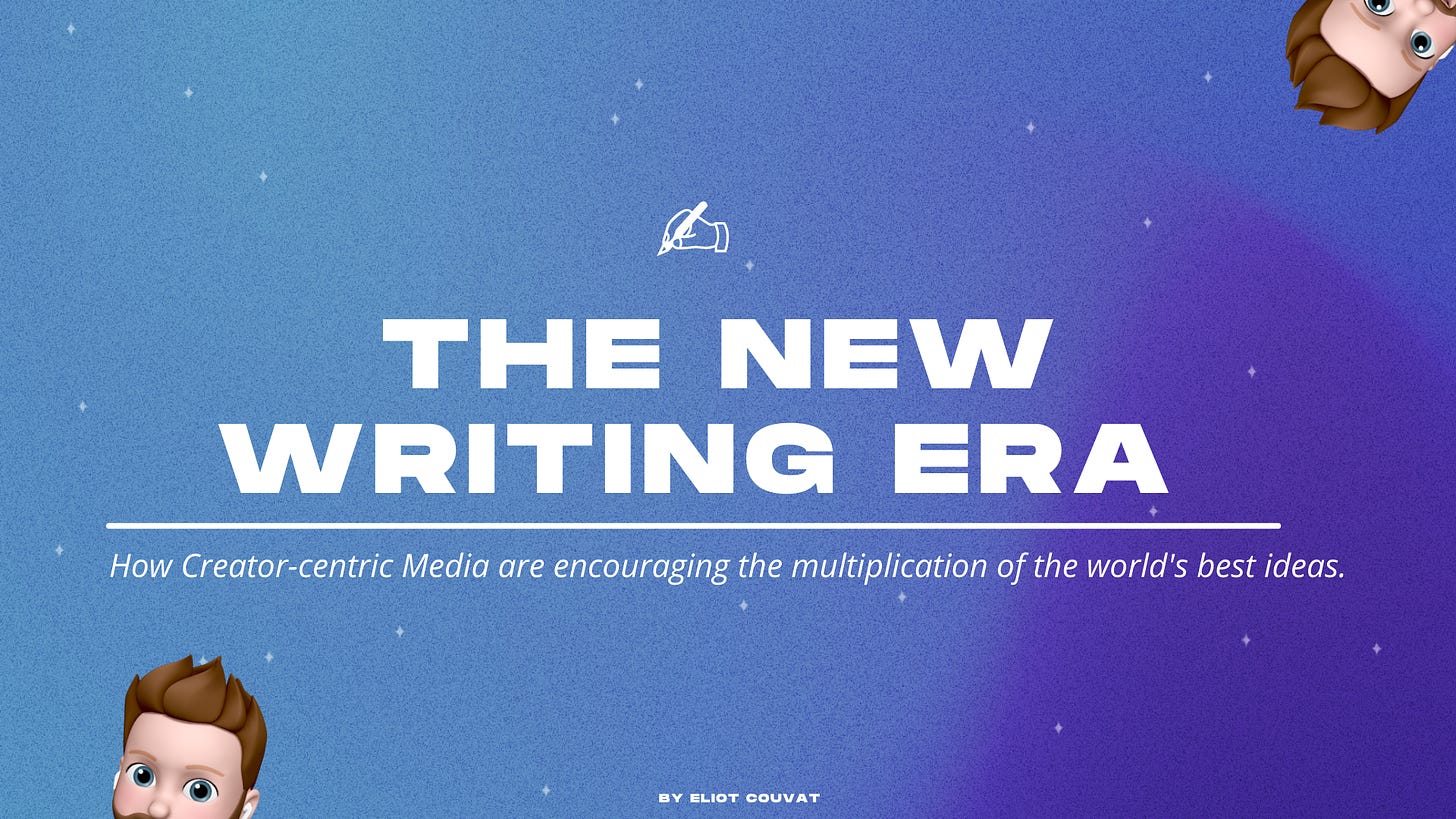What Decentralized Media Means To The Future of Digital Writing
How Creator-centric Media are encouraging the multiplication of the world's best ideas.
I’m publishing about Social Tokens & Web3 more broadly, exploring the possibilities this new revolution is unlocking. If this sounds appealing to you, make sure to subscribe to this newsletter. Enjoy! 🔥
If you’re not a subscriber yet, here’s what you missed this month:
Writing is an essential component of innovation and is, before anything else, a collaborative process where ideas are discussed, different points of view are shared, and feedback is given.
Vitalik Buterin, the founder of Ethereum, first started by putting down his thoughts on paper before actually starting to code.
In late 2013, Vitalik Buterin, wrote down his first ideas for what Ethereum could look like, and sent it out to a few friends for feedback. As a result, more than 30 people reached out to Vitalik to discuss the concept, and, over time, the vision changed to become the early foundation of Ethereum as we know it today.
Without writing, we might never had ground-breaking innovations that are part of our daily lives.
Despite writing being critical for innovation, and though most of our activities have moved to the digital world, writers’ tools to coordinate and collaborate in a digitally-native way haven't much evolved.
Collaborations between creators still happen:
In informal ways
Only when true friendships are created
In non-scalable contexts
But last year’s seminal post on Decentralized Autonomous Media Networks (DAMN) is putting words to a mounting trend in on-chain social architectures for better writing collaborations.
We’re on the verge of the next evolution of networked media, and the life of millions of writers is about to change.
Most internet content we’ve consumed for the past 10 years has been brand-centric.
As a myriad of articles dating back to 2015 on the nature of digitally-represented brands stated - “Every company is a media company”.
For years, brands have weaved their own product narratives into the storylines of their consumers—with the explicit purpose of driving consumption and revenue.
Sari Azout summarized this so well in a tweet:


The fact is, brand-centric content is optimized for driving revenue, not for the quality of original content.
Worse, this incentive misalignment between readers and brands resulted in a lack of development for writers' collaborative tools.
Brands have been playing into existing audience niches as well as conduit their own distinct social identity, meaning that the cost of the competition has always outweighed the case for collaboration.
Brands needed their readers to buy THEIR products, not others'.
But with the rise of the Creator Economy, more writers slowly became their own media.
And for those solo writers, the script is flipped — content's quality matters more than anything else.
For this new wave of writers, think Packy McCormick or Mario Gabriele, content is not a great add-on to sell a product.
Writers become the source of consumption, and their product is inherently their creativity.
Unlike other products of consumption, creativity is not a scarcity market, and writers have two main upsides to shared creativity:
It helps them come up with new ideas - Because creativity doesn't strike in a snap of a finger, writers can't rely solely on their imagination for consistent content creation. They can't perceive the world in new ways and make connections between seemingly unrelated phenomena alone.
By curating things across different creators, you actually increase the aggregate value of consumption (creativity) for all creators.
While brands write content to make readers consume, creator-centric content is all about content that's generated, managed, and controlled by people, for people—with minimal intervention of any external management.
In this new paradigm, everyone is engaged in the unprecedented exercise of shaping the content they want to see by getting ownership.
This new context makes everyone optimize for collaboration.
When content becomes owned by people for people, it completely changes the nature of collaboration and content.
The individual becomes the atomic unit again, and stories are now open-ended, branching, hyperlinked, cross-media, participatory, exploratory, and unpredictable.
This modern form of storytelling picks up these new types of stories and runs with them, accelerating the pace of creation and participation while revealing new directions for narratives to flow.
In these new media run by writers, the community becomes the catalyst for content ideas.
And these new media need ways for anyone globally to contribute autonomously.
These new forms of media, also called Decentralized Autonomous Media Organizations (DAMNs), are communities relying on governance minimization, not maximization, to help writers and curators coordinate without voting or explicit communication between members.
Under this new form of "organization," writers can:
Formalize the relations happening in the group and create a social graph.
Incentivize through tokens.
Better distribute their content.
In an economy where everyone is fighting for attention, the groups which can form, join forces toward the same goal, and capture attention will win.
Creator economy's tools such as Substack have provided better tools for creators to produce their content —DAMNs are now letting writers better distribute it.
And I can't emphasize enough the importance DAMNs will play on writers' distribution moving forward.
DAMNS are the absolute best way to capture attention and distribute content.
As Joey DeBruin pointed out in a recent essay:
"Decentralization is not the best way to make a bottle of ketchup, but in the world where every person is their own discovery and distribution engine, decentralization can absolutely become the best way to curate and sell the best ketchup."
Tell another way, writers don't need a community to create the content or define the editorial line, they need a community that curates original ideas and shares them with the world once they've been assembled by writers themselves.
Modern writers shouldn’t focus on decentralizing the content creation as the strategy for their decentralized media, but make the content the execution and the distributions the strategy.
Closing thoughts
From microcontent—with a prominent subgenre dubbed "Twitterature"—to nanofiction, new narrative genres are slowly transforming the ways we think, create, and explore.
With those new forms of narratives, more people realize the limitless opportunities that writing and collaborating online opens up. We're slowly seeing the rise of new digitally-native Media (DAMNs) — encouraging the multiplication of the world's best ideas.
The combined energy of those new trends will create a new paradigm that'll support more unique modes of expression and a new generation of artists — allowing modern writers to finally express themselves through their art, like no writer before them.
The next decade will be an exciting time for digital writers…
As someone who went through the ups & downs of content creation and Web3 community building, I can assist you in two ways:
The 5 Pillars of Web3 Community Building: If you need help starting & growing your community, I’ve written a free 40-pages guide with all the best practices I've discovered to launch, grow and monetize your Web3 community. Grab a copy here:
The Modern Web3 Community Builder - A Handbook to Collective Symbol System: If you’ve already created a community and are now looking to unlock the next phase of your journey, I’ve created a written course that’ll show you how to arouse a feeling of belonging and expand your community’s culture.






Love this piece, it's really amazing how so many of us are converging around decentralized media. Can't wait to see more!
Absolutely. All of this. And weirdly enough, it’s super easy for this to happen even on relatively centralized networks as well. When Substack added recommendations, suddenly a whole artists community I’m part of became a public-facing cooperative network, with all our prominent cross links working together to elevate our artistic output as a whole. Exciting times.